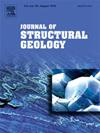基于图的裂缝网络分析,整合构造地质性质,识别瑞士阿尔卑斯山Tsanfleuron含水层系统的优先流动路径
IF 2.9
2区 地球科学
Q2 GEOSCIENCES, MULTIDISCIPLINARY
引用次数: 0
摘要
图论已成为分析裂缝网络和补充传统几何描述的一种很有前途的方法。它强调了网络的拓扑方面,强调了裂缝在提高渗透率和影响流体各向异性方面的重要性。然而,在单一框架中整合不同的构造地质分析仍然是一个挑战。我们提出了一种结合几何、拓扑、运动学、年龄关系和地质力学的基于图的裂缝网络分析,以识别网络中最重要的连接。我们将其应用于西阿尔卑斯山脉地区Tsanfleuron岩溶含水层系统,裂缝在地下水循环和岩溶作用中起着至关重要的作用。我们从高分辨率数字高程模型(DEM)、3D点云数字露头模型(DOM)、实地调查和一条扫描线中获得了新的结构数据。我们以1:25 .500 (DEM)解释和测量了轮廓,并测量了姿态(DOM)。在现场进行了验证,增加了更多的测量和运动学。将裂缝网络转换成图形,测量值以属性形式存储。研究地点按时间顺序确定了四组主要的亚垂直裂缝:E-W(85°)、NE-SW(57°)、N-S(176°)和NW-SE(117°)。截断骨折被确定为无偏长度,并定义了对集的邻近关系,以定义年龄关系。E-W和NE-SW是整个地区最持久和最长的裂缝。N-S集合集中在中心区域,NW-SE集合与其他集合重叠。NE-SW和E-W断裂的位移多为右旋,N-S和NW-SE断裂的位移多为左旋。古张量分析结果为NW-SE向最大压缩。裂缝被打开,并常常因溶解作用而扩大。就渗透而言,连通性是中等的。中间和渗透中心性突出了水流向NE、ENE和E方向的优先性。本文章由计算机程序翻译,如有差异,请以英文原文为准。
Graph-based fracture network analysis to integrate structural geology properties and identify preferential flow pathways in the aquifer system of Tsanfleuron, Swiss Alps
Graph theory has emerged as a promising method for analyzing fracture networks and complementing traditional geometrical descriptions. It emphasizes the network’s topological aspects, highlighting the importance that fractures have in enhancing permeability and influencing flow anisotropy. However, integrating different structural geology analyses in a single framework remains a challenge. We propose a graph-based fracture network analysis combining geometry, topology, kinematics, age relationships, and geomechanics to identify the most important connections within a network. We apply it to the karstic aquifer system of Tsanfleuron, in the Western Helvetic Alps domain, where fractures play a crucial role in groundwater circulation and karstification. We acquired new structural data from a high-resolution digital elevation model (DEM), a 3D point cloud digital outcrop model (DOM), fieldwork, and one scanline. We interpreted and measured lineaments in 1:2.500 (DEM) and measured attitudes (DOM). Verification was done in the field, adding more measurements and the kinematics. The fracture network was transformed into a graph, and measurements were stored as attributes. Four main subvertical fracture sets were identified in chronological order, for the study site: E-W (85°), NE-SW (57°), N-S (176°), and NW-SE (117°). Censored fractures were identified to unbiased length, and abutting relationships were defined for pairs of sets to define age relationships. The E-W and NE-SW are the most persistent and longer fractures through all the site. The N-S set is localized in the central area, and the set NW-SE superimposes the others. The displacement is mostly dextral for the NE-SW and E-W faults, and sinistral for the N-S and NW-SE sets. Paleo tensor analysis results in NW-SE directed maximum compression. Fractures are opened and often enlarged by dissolution. Connectivity is moderate in terms of percolation. Betweenness and percolation centralities highlight the preferential water flow towards NE, ENE, and E.
求助全文
通过发布文献求助,成功后即可免费获取论文全文。
去求助
来源期刊

Journal of Structural Geology
地学-地球科学综合
CiteScore
6.00
自引率
19.40%
发文量
192
审稿时长
15.7 weeks
期刊介绍:
The Journal of Structural Geology publishes process-oriented investigations about structural geology using appropriate combinations of analog and digital field data, seismic reflection data, satellite-derived data, geometric analysis, kinematic analysis, laboratory experiments, computer visualizations, and analogue or numerical modelling on all scales. Contributions are encouraged to draw perspectives from rheology, rock mechanics, geophysics,metamorphism, sedimentology, petroleum geology, economic geology, geodynamics, planetary geology, tectonics and neotectonics to provide a more powerful understanding of deformation processes and systems. Given the visual nature of the discipline, supplementary materials that portray the data and analysis in 3-D or quasi 3-D manners, including the use of videos, and/or graphical abstracts can significantly strengthen the impact of contributions.
 求助内容:
求助内容: 应助结果提醒方式:
应助结果提醒方式:


